Atlanta: Tropical Storm Helene has unleashed catastrophic flooding across the Carolinas on Friday after wreaking havoc in Florida and Georgia overnight. The storm left at least 33 dead, devastated communities, and knocked out power to more than 4 million homes and businesses.
Initially hitting Florida’s Big Bend as a formidable Category 4 hurricane at 11:10 p.m. ET Thursday (0310 GMT Friday), Helene’s 140 mph (225 kph) winds brought destruction to coastal towns. Streets were submerged, cars washed away, trees toppled, and boats were overturned in harbors.
Emergency responders carried out thousands of water rescues across the region, with Atlanta seeing an entire apartment complex evacuated due to flooding. Despite weakening into a tropical storm as it moved into Georgia early Friday, Helene continued its destructive path, slowing down over Tennessee and Kentucky. By early afternoon, it had been downgraded to a tropical depression, packing winds of 35 mph (55 kph), according to the National Hurricane Center (NHC).
However, the storm’s torrential rains were still causing severe flooding in the southern Appalachians. In Tennessee, more than 50 people were trapped on the roof of a hospital in Unicoi County, around 120 miles northeast of Knoxville, as rising waters from the Nolichucky River prevented ambulances from reaching the facility. Emergency crews began rescuing patients by boat, according to local reports.
In North Carolina, emergency officials warned residents near the Lake Lure Dam in Rutherford County of an imminent dam failure, urging them to evacuate to higher ground. Nearby, landslides forced the closure of interstates 40 and 26 in Buncombe County, officials said on social media platform X.
Widespread Destruction in Florida
Daybreak revealed the full extent of the damage in Florida. A storm surge between 8 to 10 feet (2.4 to 3 meters) hit coastal towns, sweeping mobile homes off their foundations. In Steinhatchee, the surge left roads impassable, while in Treasure Island, grounded boats were strewn across residents’ front yards.
Tampa authorities reported 78 water rescues overnight, and in Pasco County, over 65 people were saved from rising waters. The U.S. Coast Guard rescued nine people, including a man and his dog, from storm-battered waters near Sanibel Island after their sailboat was disabled.
Florida’s emergency management director, Kevin Guthrie, urged residents to avoid traveling through storm-hit areas, emphasizing the need to clear roads for search and rescue teams. “I beg you, do not go out,” Guthrie said in a morning briefing. “We have 1,500 search and rescue personnel in the impacted areas. Please get out of the way so we can do our jobs.”
Officials had repeatedly urged people to evacuate, with NHC Director Michael Brennan warning that Helene’s storm surge would be “unsurvivable.” In Taylor County, the Sheriff’s Department took the unusual step of advising residents to write their names and birthdates on their arms in permanent ink for identification in case of a tragedy.
Despite these warnings, some chose to stay. Ken Wood, a 58-year-old ferry operator in Pinellas County, shared his terrifying experience of riding out the storm at home with his 16-year-old cat, Andy. “I’ll never do that again, I swear,” Wood said. “It was a harrowing experience. It roared all night like a train. The house shook.”
Several of Wood’s neighbors were less fortunate. Pinellas County Sheriff Bob Gualtieri confirmed that emergency responders were unable to attend to numerous calls due to the dangerous conditions. On Friday, authorities found at least five bodies in the county. Two other fatalities were confirmed by Florida Governor Ron DeSantis.
In Georgia, Governor Brian Kemp reported 11 deaths due to the storm, while North Carolina Governor Roy Cooper confirmed two fatalities in his state. South Carolina reported at least 13 dead, according to local officials cited by the Post and Courier.
Also Read | Ukraine Faces New Threat from Russia’s Long-Range Orion Drones
An Unusually Large Storm
Helene’s size was remarkable for a Gulf hurricane. Although not the strongest in terms of maximum sustained winds, its tropical-storm-force winds extended up to 310 miles (500 km) from the center, far wider than other recent hurricanes. For comparison, Hurricane Idalia, which also struck Florida’s Big Bend region last year, had tropical-storm winds extending only 160 miles (260 km) before making landfall.
Airports in Tampa, Tallahassee, and St. Petersburg were closed on Thursday but resumed operations by Friday, albeit with significant delays. As of midday Friday, over 4.6 million homes and businesses across Florida, Georgia, the Carolinas, and other states were without power, according to the tracking website Poweroutage.us.



